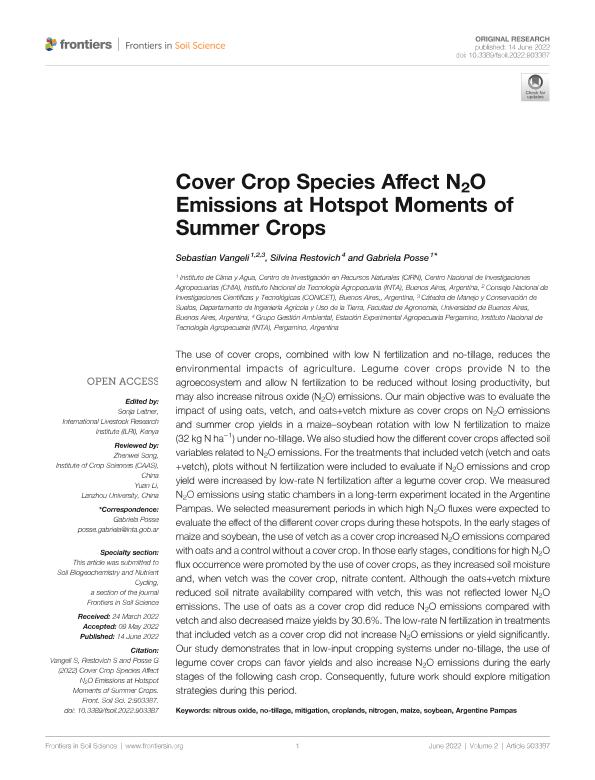Mostrar el registro sencillo del ítem
dc.contributor.author
Vangeli, Sebastián

dc.contributor.author
Restovich, Silvina Beatriz

dc.contributor.author
Posse Beaulieu, Gabriela

dc.date.available
2023-06-16T17:52:54Z
dc.date.issued
2022-06
dc.identifier.citation
Vangeli, Sebastián; Restovich, Silvina Beatriz; Posse Beaulieu, Gabriela; Cover Crop Species Affect N2O Emissions at Hotspot Moments of Summer Crops; Frontiers Media; Frontiers in Soil Science; 2; 6-2022; 1-11
dc.identifier.issn
2673-8619
dc.identifier.uri
http://hdl.handle.net/11336/200886
dc.description.abstract
The use of cover crops, combined with low N fertilization and no-tillage, reduces the environmental impacts of agriculture. Legume cover crops provide N to the agroecosystem and allow N fertilization to be reduced without losing productivity, but may also increase nitrous oxide (N2O) emissions. Our main objective was to evaluate the impact of using oats, vetch, and oats+vetch mixture as cover crops on N2O emissions and summer crop yields in a maize–soybean rotation with low N fertilization to maize (32 kg N ha−1) under no-tillage. We also studied how the different cover crops affected soil variables related to N2O emissions. For the treatments that included vetch (vetch and oats+vetch), plots without N fertilization were included to evaluate if N2O emissions and crop yield were increased by low-rate N fertilization after a legume cover crop. We measured N2O emissions using static chambers in a long-term experiment located in the Argentine Pampas. We selected measurement periods in which high N2O fluxes were expected to evaluate the effect of the different cover crops during these hotspots. In the early stages of maize and soybean, the use of vetch as a cover crop increased N2O emissions compared with oats and a control without a cover crop. In those early stages, conditions for high N2O flux occurrence were promoted by the use of cover crops, as they increased soil moisture and, when vetch was the cover crop, nitrate content. Although the oats+vetch mixture reduced soil nitrate availability compared with vetch, this was not reflected lower N2O emissions. The use of oats as a cover crop did reduce N2O emissions compared with vetch and also decreased maize yields by 30.6%. The low-rate N fertilization in treatments that included vetch as a cover crop did not increase N2O emissions or yield significantly. Our study demonstrates that in low-input cropping systems under no-tillage, the use of legume cover crops can favor yields and also increase N2O emissions during the early stages of the following cash crop. Consequently, future work should explore mitigation strategies during this period.
dc.format
application/pdf
dc.language.iso
eng
dc.publisher
Frontiers Media

dc.rights
info:eu-repo/semantics/openAccess
dc.rights.uri
https://creativecommons.org/licenses/by-nc-sa/2.5/ar/
dc.subject
NITROUS OXIDE
dc.subject
NO-TILLAGE
dc.subject
MITIGATION
dc.subject
CROPLANDS
dc.subject.classification
Ciencias del Suelo

dc.subject.classification
Agricultura, Silvicultura y Pesca

dc.subject.classification
CIENCIAS AGRÍCOLAS

dc.title
Cover Crop Species Affect N2O Emissions at Hotspot Moments of Summer Crops
dc.type
info:eu-repo/semantics/article
dc.type
info:ar-repo/semantics/artículo
dc.type
info:eu-repo/semantics/publishedVersion
dc.date.updated
2023-06-15T13:41:45Z
dc.journal.volume
2
dc.journal.pagination
1-11
dc.journal.pais
Suiza

dc.description.fil
Fil: Vangeli, Sebastián. Instituto Nacional de Tecnología Agropecuaria. Centro de Investigación de Recursos Naturales. Instituto de Clima y Agua; Argentina. Universidad de Buenos Aires. Facultad de Agronomía. Departamento de Ingeniería Agrícola y Uso de la Tierra; Argentina. Consejo Nacional de Investigaciones Científicas y Técnicas; Argentina
dc.description.fil
Fil: Restovich, Silvina Beatriz. Instituto Nacional de Tecnología Agropecuaria. Centro Regional Buenos Aires Norte. Estación Experimental Agropecuaria Pergamino; Argentina
dc.description.fil
Fil: Posse Beaulieu, Gabriela. Instituto Nacional de Tecnología Agropecuaria. Centro de Investigación de Recursos Naturales. Instituto de Clima y Agua; Argentina. Consejo Nacional de Investigaciones Científicas y Técnicas; Argentina
dc.journal.title
Frontiers in Soil Science
dc.relation.alternativeid
info:eu-repo/semantics/altIdentifier/url/https://www.frontiersin.org/articles/10.3389/fsoil.2022.903387/full
dc.relation.alternativeid
info:eu-repo/semantics/altIdentifier/doi/http://dx.doi.org/10.3389/fsoil.2022.903387
Archivos asociados
